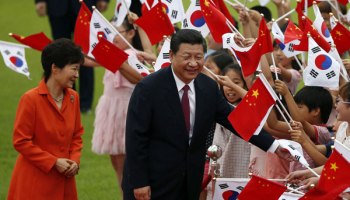 |
No intrinsic value: Unlike enterprises, bitcoin has no business, no intrinsic value, no cash flows and no balance sheet. — AFP
|
I JUST returned from a meeting of the Asian Shadow Financial Regulatory Committee in Bangkok.
The group comprises Asian academic experts on economics and finance. Their role is to monitor the state of the world economy and the workings of its financial markets in the light of existing and prospective policies; and draw lessons and give advice on vital public policy issues of current interest to regulators and market practitioners to make the world a better place.
The group comprises 23 professors from 14 countries, coming from a diverse group of universities and think-tanks, including the universities of Sydney and Monash, and of Fudan, Hong Kong and Sun-Yat-Sen in China, Universitas Indonesia, universities of Tokyo and Hitotsubashi, Yonsei and Korea universities, Sunway University, Massey University in New Zealand, University of the Philippines, Singapore Management University, National Taiwan University, Chulalongkorn University and NIDA Business School, University of Hawaii and University of California at Davis, University of Vietnam, and Tilburg University in the Netherlands.
They examined key issues surrounding the theme: “Cryptocurrencies: Quo Vadis?” focusing on the role and activities of the flavour of the month, bitcoin. At the end of it all, they issued the following statement:
“Cryptocurrencies in general, and bitcoin, in particular, have been receiving considerable press of late, driven mainly by wide swings in value in the cryptocurrency exchanges. There are now in excess of 2,500 products considered to be cryptocurrencies and in the last three weeks alone their combined market value has plummeted from US$830bil to US$545bil as of today, of which US$215bil is attributed to bitcoin and bitcoin cash.
To keep this in perspective, however, Apple Inc has a market value of US$880bil as of today. Market value measures the equity value of a business – or what investors are willing to pay for its future profits.
Unlike enterprises, however, bitcoin has no business, no intrinsic value, no cash flows, no profit and loss statement, and no balance sheet. It is a speculative instrument.
Cryptocurrencies, including bitcoin, are not considered currency today because they are not a universal means of payment, nor a stable store of value, nor a reliable unit of account. Buyers purchase on the basis that these cryptocurrencies would rise in value. While market value has been the main focus of the current interest, the more important issues are around the role of cryptocurrencies both as financial assets, and the role they can play in transaction settlements, and their implications, if any, on financial stability.
While there is much interest in cryptocurrencies, especially bitcoin, the volume of transactions remains very small currently. For example, total US dollars (cash) in circulation amount to US$1.6 trillion as of today. M3 (broad money) is valued by the Federal Reserve at US$14 trillion. Total US economy assets in 2016 were valued at US$220 trillion. So why the fascination with cryptocurrencies? Supporters of Bitcoin claim it to be a superior store of value to fiat money issued by central banks because its supply is limited by design and therefore cannot be debased. In addition,
the technology behind bitcoin, called the Blockchain, provides anonymity to its players. That is why it is a favourite with money launderers, tax evaders, terrorists, drug smuggler, hackers, and anyone who wants to evade the rule of law. Many people who use cryptocurrencies assert that they pay minimal transaction costs mainly because it avoids the cost of financial intermediation.
Still, there is large potential for capital gains because of the wide volatility of its price movement. This is the main driving force behind the popularity of cryptocurrencies like bitcoin. However, there are high risks involved including extreme volatility and opaque, unregulated exchanges that are prone to cyberattacks.
Authorities and regulators worry about bitcoin because they fear it is a bubble. In the event of a bust, investors in bitcoin – they are many, spread over various continents and countries – will be hurt; and they exert pressure on governments to regulate this business in order to protect investors.
In addition, they worry about the impact – in the event that cryptocurrency trading becomes a significant element in maintaining financial stability – in terms of the impact on the transmission of monetary policy and on its effects on the banking system, and most of all, on systemic risk, if any.
Authorities have responded in different way. In South Korea, new regulations today require banks and exchanges to identify who their customers are, imposing greater transparency in the conduct of the cryptocurrency business. On the other hand, Japanese authorities are more liberal. They only require the registration of companies engaged in this business at this time.
Many other authorities, including those in the US, are adopting a wait-and-see attitude while studying the issues, recognising that there may be a role for them to introduce some regulatory measures in the event that the volume and price volatility of cryptocurrency transactions become more and more significant.
In the meantime, government and tax authorities feel uneasy about the impact on revenue collection. Other regulators are worried about crowdfunding through ICOs (initial coin offers). Authorities in a number of countries, including the US, have introduced measures to regulate the issue of new ICOs to ensure that investors are provided with the necessary information before making such investments.
At the same time, central banks in many countries are looking into the desirability and possibility of issuing their own digital currencies, including to counter privately-issued cryptocurrencies.
Recommendations:
1. Bitcoin came into prominence because of an apparent lack of confidence in fiat currency. It is imperative that governments and central banks continue to give priority to (i) protecting the integrity of their currencies; (ii) designing policies to contain inflation to prevent it from debasing the currency; and (iii) strengthening their mandate to promote financial stability over financial development, if needed (including ensure fintech development does not undermine confidence). Also, in cases where authorities do not have the power to regulate the cryptocurrency business, they should actively seek such authority where appropriate.
2. Monetary authorities should be open to creating digital currencies rather than confining their money supply to notes, coins and deposits. But they should do so in a transparent manner and only after careful consultation and study.
3. It is the role of government to warn their citizens and investors about the high risk involved, and ensure transparency in bitcoin activity, and not to unduly introduce more and more regulations that will stifle innovative initiatives.
Blockchain technology, for example, does have other useful applications apart from the issue of its use in the creation of digital currency.
Investor protection
As we see today, bitcoin and the other cryptocurrencies are not currencies. Mostly, they reflect speculative activity. Hence, investing and transacting in them involve high risks. It is imperative that investors realise this and approach investing in cryptocurrencies with great caution and with as much information as is available to help them manage these risks.
Investors must fully understand that cryptocurrency prices need not necessarily always rise, particularly because they have no intrinsic value, they could just as easily fall. So investors beware: Caveat emptor.”
Update
The following developments are noteworthy:
> Columbia’s Prof N. Roubini (Dr Doom) claims bitcoin is not a currency. Few price anything in bitcoin. Not many retailers accept it (even bitcoin conferences don’t accept it as payment). And it’s a poor store of value because its price can fluctuate 20%-30% a day. Worse, he labelled it “the mother of all bubbles” because its claim of a steady-state supply is “fraudulent”.
It has already created thee similar currencies: Bitcoin Cash, Litecoin and Bitcoin Gold. Together with the hundreds of such other currencies invented daily, this creation of money supply is debasing the currency at a much faster pace than any major central banks ever did. Furthermore, bitcoin’s claimed advantage is also its Achilles’s heel – for, even if it actually did have a steady supply of 21 million units, it is not a viable currency because the supply won’t track potential nominal GDP growth; hence, prices will become deflationary – the kind of phenomenon that economist Irving Fisher believed caused the Great Depression.
Indeed, the head of the European Central Bank had since declared to the European Parliament that cryptocurrencies are unregulated and “very risky assets. Their price is entirely speculative”. That’s not what we want or need. It’s a pity the FOMO (fear of missing out) of many retail investors will end them in a wild goose ride!
> Over its nine-year history, bitcoin has had five-peak-to-trough falls of more than 70% each. The recent decline offers a dose of reality to new investors – bitcoin dropped to a low US$7,850 on Feb 2 for the first time since November 2017 – crashing 60% from the high of nearly US$20,000 in mid-December. Sentiment has shifted dramatically this year.
On Feb 5, it fell another 4% to US$7,524. Also, the fledging market has taken a number of blows: Facebook has since banned advertisements on it (for being misleading); US Securities and Exchange Commission has accused some latest ICOs as “outright scams”; US and UK largest banks have put up “road-blocks” to financing bitcoins; and the recent Japanese hack theft of 523 million crypto-XEM (worth US$500mil) brought back memories of Mt Gox, which collapsed after a similar hack in 2014.
> Arbitrage traders (buying where it’s cheap and reselling where it is dear) have been active – taking advantage of price differentials in multiple places and different times. They call it “capturing the arb”. Hedge funds, high frequency traders and even amateur enthusiasts are giving it a shot. Price divergences can be due to glitches or network traffic jams. In South Korea, exchanges quote abnormally wide prices reflecting high investors’ demand for bitcoin in the face of strict capital controls – giving rise to a “Kimchi premium” (of as high as 50% above US price; now down to 5% as price disparities are swiftly traded away).
> Concern over cryptocurrency activity is spreading beyond China, Japan, South Korea and India. This prompted the governor of the Bank of England, who also chairs the Global Financial Stability Board, to voice his unease over the anonymity embedded in blockchain technology underlying their use, especially for illicit activity (including money laundering). He disclosed that it would be on the agenda at the next G20 meeting. Tax authorities have also expressed concern over the under-reporting of capital gains tax.
> Bitcoin futures trading on Chicago’s CME and CBoE exchanges have been slow to catch fire – at the pace of a “slow walk”.
What then, are we to do
Reality check: Bitcoin is proving that cryptocurrencies can erase wealth as fast as they create it. In January 2018 alone, it wiped off US$45bil from its US$200bil in market value generated in all of 2017 – the biggest one-month loss in US dollar terms in its short history. Since then, more value is being lost. For most economists and finance experts, they don’t represent an investable asset – there are liquidity issues, safety issues, exchange issues; most of all, they have no intrinsic value.
Can’t realistically put a fix on their fair value. They are for speculators who are prepared to lose everything. Of course, its something else for those who use them for illicit activity (home to criminals and terrorists), including money laundering. Anonymity means you are potentially closing a chain, while at somewhere along it had some illicit activity that cannot see the light of day.
Fair enough, these concern regulators. But we shouldn’t lose sight of the huge range of opportunities presented by the underlying technology – a view shared by many in relation to raising the efficiency of payment systems. Regulators are right to want to regulate crypto but also, continue to encourage innovation on blockchain. As I see it, so far in 2018, bitcoin has been a total dud. The list of factors driving its decline is growing, especially rising regulatory clampdown occurring around the world.
So, the cryptocurrency market has fallen on tougher times. For sure, Bitcoin has been highly profitable for many investors. Indeed, there continues to be strong interest among millennials.
Bottom line: the year so far has been terrible for bitcoin. But the fundamental positive story for crypto appears to remain intact. Protecting consumers should make it harder for charlatans to sell digital dust. There is a point where it goes from “buying on the dip” to “catching a falling knife”. Only time will tell. So, beware!
NB: Following global regulatory crackdown, bitcoin’s price has on Feb 6 fallen to a low of US$5,947, wiping out over US$200bil so far this year. Bitcoin’s market cap is now US$109bil, about one-third of the total crypto market (that’s down from 85% this time last year). The Bank for International Settlements (banker to central banks) has now condemned bitcoin as “a combination of a bubble, a Ponzi scheme and an environmental disaster” (refers to huge amounts of electricity used to create it) and warns it can even become a “threat to financial stability”.

By Lin See-yan - what are we to do?
Former banker Tan Sri Lin See-Yan is the author of The Global Economy in Turbulent Times (Wiley, 2015) and Turbulence in Trying Times (Pearson, 2017). Feedback is most welcome.
 Related posts
Related posts
Related News:
















